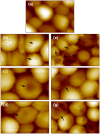Quantitative and qualitative analysis of the antifungal activity of allicin alone and in combination with antifungal drugs
- PMID: 22679493
- PMCID: PMC3367977
- DOI: 10.1371/journal.pone.0038242
Quantitative and qualitative analysis of the antifungal activity of allicin alone and in combination with antifungal drugs
Abstract
The antifungal activity of allicin and its synergistic effects with the antifungal agents flucytosine and amphotericin B (AmB) were investigated in Candida albicans (C. albicans). C. albicans was treated with different conditions of compounds alone and in combination (allicin, AmB, flucytosine, allicin + AmB, allicin + flucytosine, allicin + AmB + flucytosine). After a 24-hour treatment, cells were examined by scanning electron microscopy (SEM) and atomic force microscopy (AFM) to measure morphological and biophysical properties associated with cell death. The clearing assay was conducted to confirm the effects of allicin. The viability of C. albicans treated by allicin alone or with one antifungal drug (AmB, flucytosine) in addition was more than 40% after a 24-hr treatment, but the viability of groups treated with combinations of more than two drugs was less than 32%. When the cells were treated with allicin alone or one type of drug, the morphology of the cells did not change noticeably, but when cells were treated with combinations of drugs, there were noticeable morphological changes. In particular, cells treated with allicin + AmB had significant membrane damage (burst or collapsed membranes). Classification of cells according to their cell death phase (CDP) allowed us to determine the relationship between cell viability and treatment conditions in detail. The adhesive force was decreased by the treatment in all groups compare to the control. Cells treated with AmB + allicin had a greater adhesive force than cells treated with AmB alone because of the secretion of molecules due to collapsed membranes. All cells treated with allicin or drugs were softer than the control cells. These results suggest that allicin can reduce MIC of AmB while keeping the same efficacy.
Conflict of interest statement
Figures





Similar articles
-
Quantitative and qualitative analyses of the cell death process in Candida albicans treated by antifungal agents.PLoS One. 2011;6(12):e28176. doi: 10.1371/journal.pone.0028176. Epub 2011 Dec 9. PLoS One. 2011. PMID: 22174777 Free PMC article.
-
Allicin enhances the oxidative damage effect of amphotericin B against Candida albicans.Int J Antimicrob Agents. 2009 Mar;33(3):258-63. doi: 10.1016/j.ijantimicag.2008.09.014. Epub 2008 Dec 17. Int J Antimicrob Agents. 2009. PMID: 19095412
-
The vacuole-targeting fungicidal activity of amphotericin B against the pathogenic fungus Candida albicans and its enhancement by allicin.J Antibiot (Tokyo). 2009 Dec;62(12):691-7. doi: 10.1038/ja.2009.103. Epub 2009 Oct 30. J Antibiot (Tokyo). 2009. PMID: 19876074
-
Enhancement of the fungicidal activity of amphotericin B by allicin, an allyl-sulfur compound from garlic, against the yeast Saccharomyces cerevisiae as a model system.Planta Med. 2006 Oct;72(13):1247-50. doi: 10.1055/s-2006-947203. Epub 2006 Aug 10. Planta Med. 2006. PMID: 16902870
-
An overview of the antifungal properties of allicin and its breakdown products--the possibility of a safe and effective antifungal prophylactic.Mycoses. 2005 Mar;48(2):95-100. doi: 10.1111/j.1439-0507.2004.01076.x. Mycoses. 2005. PMID: 15743425 Review.
Cited by
-
Multifaceted Pharmacological Potentials of Curcumin, Genistein, and Tanshinone IIA through Proteomic Approaches: An In-Depth Review.Cancers (Basel). 2022 Dec 30;15(1):249. doi: 10.3390/cancers15010249. Cancers (Basel). 2022. PMID: 36612248 Free PMC article. Review.
-
Atomic force microscopy in microbiology: new structural and functional insights into the microbial cell surface.mBio. 2014 Jul 22;5(4):e01363-14. doi: 10.1128/mBio.01363-14. mBio. 2014. PMID: 25053785 Free PMC article.
-
Allicin: chemistry and biological properties.Molecules. 2014 Aug 19;19(8):12591-618. doi: 10.3390/molecules190812591. Molecules. 2014. PMID: 25153873 Free PMC article. Review.
-
Improved Osteoblast and Chondrocyte Adhesion and Viability by Surface-Modified Ti6Al4V Alloy with Anodized TiO₂ Nanotubes Using a Super-Oxidative Solution.Materials (Basel). 2015 Mar 2;8(3):867-883. doi: 10.3390/ma8030867. Materials (Basel). 2015. PMID: 28787976 Free PMC article.
-
Anticandidal Activity of In Situ Methionine γ-Lyase-Based Thiosulfinate Generation System vs. Synthetic Thiosulfinates.Pharmaceuticals (Basel). 2023 Dec 7;16(12):1695. doi: 10.3390/ph16121695. Pharmaceuticals (Basel). 2023. PMID: 38139821 Free PMC article.
References
-
- Jun-Dong Zhang, Zheng Xu, Yong-Bing Cao, Hai-Sheng Chen, Lan Yan, et al. Antifungal activities and action mechanisms of compounds from Tribulus terrestris L. Journal of Ethnopharmacology. 2006;103:76–84. - PubMed
Publication types
MeSH terms
Substances
LinkOut - more resources
Full Text Sources
Miscellaneous

